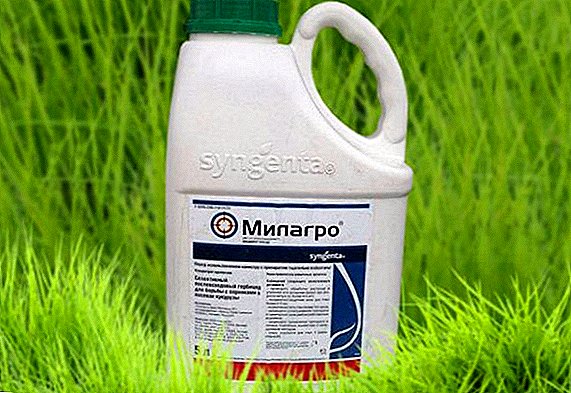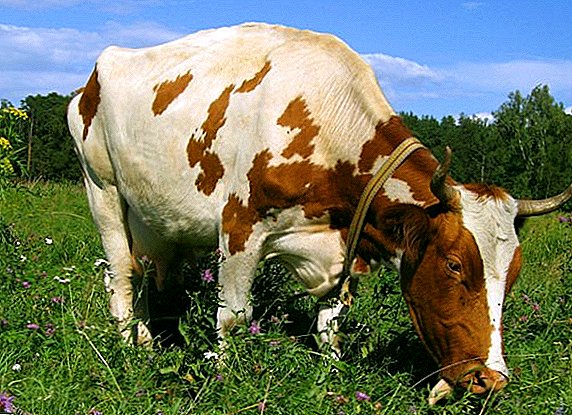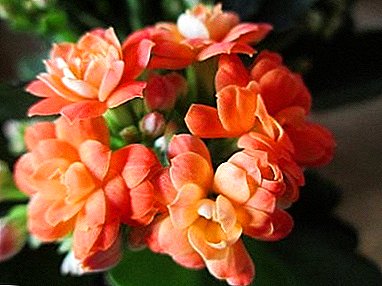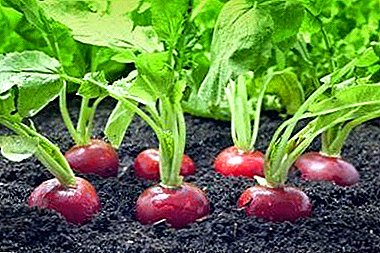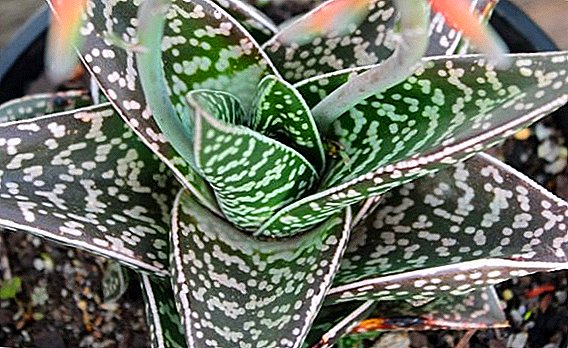 About the healing properties of aloe, or agave known since ancient times. Nowadays, it is used in traditional and traditional medicine for the treatment of many diseases, as well as in cosmetology. Many people prefer to grow it at home to have a medicinal plant on hand. The subtleties of growing one of the aloe species, namely the variegated, this article is devoted.
About the healing properties of aloe, or agave known since ancient times. Nowadays, it is used in traditional and traditional medicine for the treatment of many diseases, as well as in cosmetology. Many people prefer to grow it at home to have a medicinal plant on hand. The subtleties of growing one of the aloe species, namely the variegated, this article is devoted.
Botanical characteristics of the plant
Aloe variegated - a type of aloe. This species is also called tiger. It is named so because of the unusual color of the leaves - on a dark green background are bright stripes and spots. The leaves form an outlet and are arranged in a spiral in 3 rows. The number of leaves in one plant - from 18 to 24 pieces. Their length is 10-15 cm, width - 3-6 cm. They are triangular in shape.
In March - April, tiger aloe produces orange flowers. Inflorescence is similar to a bunch of 20-30 cm long. Flowering occurs when the plant reaches the age of 3-5 years. 
The height of the plant does not exceed 30 cm, in diameter - 5-6 cm. It has a powerful root system.
Under natural conditions, this species grows on the territory of South Africa, in Namibia. In room culture, flowers are grown in apartments, offices, lobbies, create succulent compositions from them.
Did you know? The very first entry about aloe, which is known today, dates back to 1500 BC. er The medicinal properties of the plant are described on Ebers papyrus stored at the University of Leipzig (Germany).
Medicinal properties and use
In addition to decorative qualities, variegated aloe is valued for its healing properties.
It is capable of:
- lead to the fastest recovery and healing of tissues;
- remove inflammation;
- have a laxative effect;
- stimulate the excretion of bile;
- fight against germs;
- to establish the work of the gastrointestinal tract;
- improve appetite
- thin the blood.

In folk medicine
Traditional healers advise treating aloe with the following health problems:
- Rhinitis and sinusitis. Aloe juice 2-3 drops instilled into the nasal passages.
- Cough. It is necessary to squeeze the juice from the leaves and mix it with honey in the ratio of 1 to 1. Eat 1 tsp. three times a day. Adults are well helped by a mixture of vodka (1 part), honey (1 part) and aloe juice (5 parts) infused for 10 days.
- Inflammation of the skin. Aloe leaves are cut and applied to the affected area during the day.
- Disorders in the gastrointestinal tract. Drink 20 ml of juice for 1-2 months 30 minutes before meals in the morning. Juice can be mixed with 100 ml of water and 20 g of honey. To improve digestion, a mixture of 350 g of wine, 250 g of honey and 150 g of aloe juice is prepared. She insists 5 days. Eat three times a day, 20 ml for half an hour before meals.
Learn more about the use of aloe in traditional medicine.
In cosmetology
Cosmetologists say that with the help of aloe you can get rid of many problems on the skin (lighten pigment spots, remove acne, relieve irritations, etc.), significantly improve its condition, moisturize and rejuvenate. 
Here are some recipes for the most popular and simple face masks:
- Universal. A mixture of yolk (1 pc.), Sour cream (1 tsp.), Aloe juice (1 tsp.) Apply on the face in layers after each previous one dries for 20 minutes. Wash with warm water. The course is 20 days.
- To increase the tone. For 20 minutes, apply on the skin a mush, which includes honey (1 tsp.), Castor oil (1 tsp.), Yolk (1 pc.), Aloe juice (0.5 tsp.), Juice. orange (0.5 tsp.), oatmeal.
- Moisturizing. For 20-25 minutes, smear the face and neck with a mixture consisting of yolk (1 pc.), Ground leaves of aloe (2 tbsp.), Aloe juice (2 tbsp.), Milk (2 tbsp.) Or cream (1 tbsp. l.).
Important! Aloe can cause allergic reactions, so before using it you should make sure that you are not allergic to it.
Growing conditions
Aloe is a very hardy plant: it can survive without water, at high temperatures, low air humidity. But in order for it to grow without problems at home, he needs to create his favorite conditions: good lighting and regular access to fresh air.
Temperature conditions
In spring and summer, succulent plants can easily grow in a wide range of temperatures - from + 15 ° С to + 40 ° С. Ideal conditions for it are + 18 ... + 22 ° С. In the warm season, it is advisable to keep a flower pot in the open air, for example, on a balcony or terrace.
In winter, it is necessary to create cool conditions with a temperature regime from + 12 ° С to + 14 ° С.
Air humidity
Humidity indicators for aloe are not critical, but it is better if in the room where it grows, humidity will be maintained in excess of 50%. It is not necessary to spray the plant itself - the spray is moistened at a distance from the flower.

Lighting
An important condition for the growth of succulent is good lighting, so it should be placed in a bright place, but with protection from direct sunlight - falling on the sheets, they can provoke burns.
Young aloe should be grown on windowsills facing south and east. On the north side, the flower will grow poorly. Here it is necessary for him to organize additional lighting in order to create an optimal duration of daylight hours.
Home care
Aloe is one of the plants whose care is easy and does not require much time from the owner.
Watering
When conducting irrigation in spring and summer, they are guided by the state of the soil. Moisturize produced as soon as the top layer dries. How quickly the soil will dry out depends on the temperature and humidity of the air in the room, the lighting, the composition of the soil. Usually, at a temperature of + 25 ... + 30 ° C, 2-3 waterings are performed per week.
In winter, aloe is rarely watered - no more than 1-2 times a month.
Important! Watering aloe with cold water is prohibited, especially at low temperatures. - this leads to decay of the roots.
Warm soft tap water is suitable for moistening the succulent. After dialing, it is defended in an open container for 1-2 days.
To water the succulent in two ways: the top and in the pan. When the upper watering should be poured directly under the root, ensuring that the drops do not fall into the outlet on the leaves.
Top dressing
When deciding on mandatory care activities, the owner can choose whether to do an annual agave transplant or to confine himself to replacing the upper layer and transplants as the root system grows.
In the first case, if the flower undergoes a regular procedure of transplanting into a new soil, it does not need additional dressing. It will be enough for those elements that are in the soil. 
If regular transplants are not made, then from March to September aloe needs to be fertilized 1 time in 2-3 weeks. Ready mineral complexes developed for cacti and succulents are suitable for it. In winter, during dormancy, fertilization is not carried out - it is harmful for the plant.
Pruning
Sanitary pruning aloe spend as needed. When the plant ottsvetet, from it should be cut dried flower stalks. As drying diminishes the lower leaves.
Succulent does not need forming trimmings.
Transfer
Transplantation is made in the spring - for this purpose they buy a pot and prepare the soil. Young plants up to 4 years old are transplanted annually, adults - 1 time in 3-4 years.
The best container for growing agave is a plastic pot: it retains moisture for a long time, which is good for succulents. The size of the pot should be selected in accordance with the root system. You need to focus on the fact that when you install the plant in a container from its walls to the rhizome remained at least 3 cm. The depth of the pot may be small.
Read also how to plant and grow aloe at home.
When choosing the size of the container, you can also focus on the ratio of the length of the piece to the diameter of the pot: the ideal proportions are 2 to 1.
Requirements for soil in aloe only 2:
- Good moisture and air conduction.
- Neutral or slightly alkaline level of acidity (5-7 pH).
Also, the land can be mixed independently, taking in equal shares the following components:
- turf ground with clay;
- sand;
- leaf earth;
- humus.
There are several ways to do this:
- Hold it over the steam.
- Spill with potassium permanganate solution.
- Calcify in the oven (microwave).
- Pour boiling water.
Video: Aloe Vera Transplant
To transplant a plant, you must perform the following steps:
- Wash well and pour a pot over the boiling water.
- Fully dry it.
- Lay a high layer of drainage of expanded clay, pebbles, etc.
- Pour a small layer of prepared soil substrate.
- Set the center of the pot flower.
- Sprinkle with soil, leaving 1.5-2 cm from the edge of the pot.
- To water.
- Put a layer of gravel, crushed stone or dry sand on the soil surface.
Breeding
Aloe can be propagated by cuttings (lateral leaf processes), seeds. At home, most often resort to grafting. Seed multiplication is more troublesome and takes a long time.
Learn more about how to propagate aloe at home.
Cuttings
The arrangement of a mini-greenhouse will be required for cutting. Cuttings are cut in the spring with a sharp disinfected knife. Places slices sprinkled with coal, then give them time to dry for 2-3 days.
Rooting is carried out in a container filled with wet sand. Cuttings deepened by 4 cm, and then covered with a plastic bottle and put in a warm room. Every day they are aired, moistened as needed. After the roots appear, cherkis are transplanted into pots.

Growing from seed
Sowing of seeds produced in a light, loose and moist soil, poured into a small, narrow container.
The soil mixture should consist of the following components:
- leaf earth - 1 part;
- turf - 1 part;
- sand - 0.5 parts.
Optionally, you can make it more loose with charcoal or brick chips.
We advise you to find out what soil for aloe can be used at home.
Seeds are placed on the surface of the soil, deepening them by 1 cm. Sprinkled with a layer of sand on top.
The container is covered with glass or film and placed in a room where the temperature is maintained above + 20 ° C. Seedlings periodically moisturize and air daily. At emergence of shoots the shelter is removed. After forming 3 true leaves, the sprouts swoop down into separate containers 5 cm high. You can plant them in permanent pots after 24 months.

Difficulties in growing
When creating the recommended microclimate and carrying out quality care difficulties with growing aloe should not arise. If mistakes are made during planting and care, the plant may be sick or be affected by insects.
Did you know? Residents of the countries of the Middle East believed that aloe brought longevity and prosperity into the house, so they hung the plant over the front door. There, the agave could grow without watering for several years and even bloom.
Diseases
Of the diseases most often, aloe affects root rot - it develops with systemic waterlogging. The fact that the plant is sick is indicated by the desiccation of the stem, yellowing, desiccation and abscission of the foliage. Agave is stunted in growth or stops growing altogether. To solve the problem will transplant in a new soil and pot. Damaged roots need to be removed, healthy ones should be treated with a systemic fungicide, sprinkled with carbon. Watering can be done not earlier than 3 weeks. With strong decay, you need to cut off the top, root it and grow a new plant. 
There may be other problems:
- Dry leaves. This happens because the flower is not transplanted for a long time. To fix the problem, you need to transplant the plant.
- Leaves become thin. Observed with a shortage of light or lack of moisture. It is necessary to increase the duration of daylight and to establish the recommended mode of irrigation.
- The tips of the leaves turn yellow. The reason lies in the lack of nutrients. Plant need to feed or transplant.
- There were brown spots on the foliage. Most likely, the flower feels the lack of moisture. It is necessary to adjust the watering mode.
- Formed soft dark spots on the sheets. This is a sign of infection with a fungal disease. The treatment will be treatment with a systemic fungicide approved for houseplants.
- The leaves turned red. It is necessary to rearrange the pot in a darker place or priten it. Redness of the leaves indicates a surplus of sunlight.
- Flower withers. Wilting occurs when watering with cold water or excessive moisture. To eliminate the problem you need to adjust the watering and heat the water.
You will be interested to read about the properties of aloe tree.
Pests
Agave insects can affect:
- Mealybug. This is an insect with a body length of 2-5 mm, covered with white bloom and hairs. Leaves white discharge on soil and plant. With the defeat, the growth of the plant slows down. Treatment is carried out by treatment with garlic solution, "Intavir", "Fufanon", "Decis".
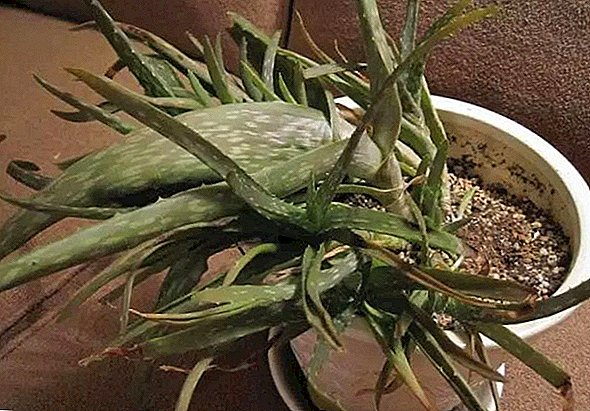
- Root nematode. This insect with a body size of 1-2 mm leads to stunted aloe. The treatment consists of treatments with Vidat, Tekta.
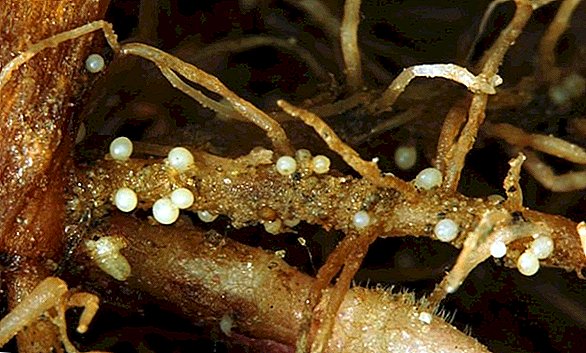
- Thrips. It is a small insect with wings 1-2 mm in size. In the course of life, it leaves streaks of silver. The plant must be sprayed with "Fitoverm", "Intavir", "Decis", the soil should be watered with "Confidor".
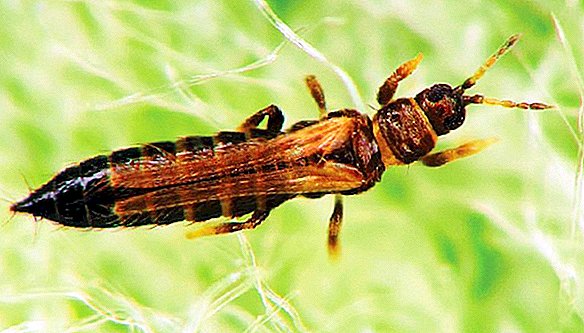
- Spider mite. After the appearance of this miniature insect of 1-2 mm in size with a black or red body, the web remains on the foliage. The stem is colored yellow or red. When infecting, the flower should be sprayed with garlic infusion, treated with Apollo, Flumaite, Sunmite. Indoors need to raise the level of humidity.

So, to grow aloe variegated at home is not difficult. It requires only good lighting, frequent airing and minimal maintenance. If you follow all the tips on growing it, you can enjoy the exotic view of a plant with striped leaves for 15 years and use its healing properties if necessary.






